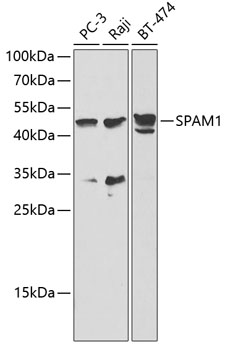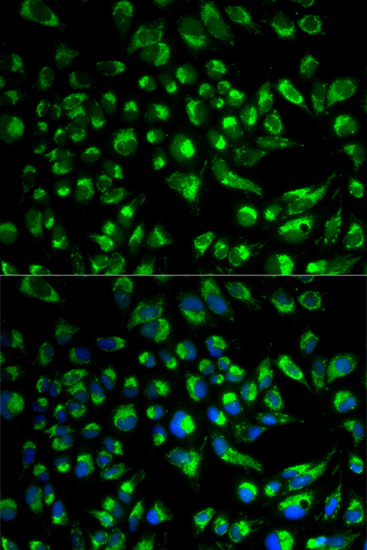-
Product Name
SPAM1 Polyclonal Antibody
- Documents
-
Description
Polyclonal antibody to SPAM1
-
Tested applications
WB, IF
-
Species reactivity
Human, Mouse, Rat
-
Alternative names
SPAM1 antibody; HEL-S-96n antibody; HYA1 antibody; HYAL1 antibody; HYAL3 antibody; HYAL5 antibody; PH-20 antibody; PH20 antibody; SPAG15 antibody; hyaluronidase PH-20 antibody
-
Isotype
Rabbit IgG
-
Preparation
Antigen: Recombinant fusion protein containing a sequence corresponding to amino acids 100-300 of human SPAM1 (NP_003108.2).
-
Clonality
Polyclonal
-
Formulation
PBS with 0.02% sodium azide, 50% glycerol, pH7.3.
-
Storage instructions
Store at -20℃. Avoid freeze / thaw cycles.
-
Applications
WB 1:500 - 1:2000
IF 1:50 - 1:200 -
Validations

Western blot - SPAM1 Polyclonal Antibody
Western blot analysis of extracts of various cell lines, using SPAM1 antibody at 1:1000 dilution.Secondary antibody: HRP Goat Anti-Rabbit IgG (H+L) at 1:10000 dilution.Lysates/proteins: 25ug per lane.Blocking buffer: 3% nonfat dry milk in TBST.

Immunofluorescence - SPAM1 Polyclonal Antibody
Immunofluorescence analysis of HeLa cells using SPAM1 antibody . Blue: DAPI for nuclear staining.
-
Background
Involved in sperm-egg adhesion. Upon fertilization sperm must first penetrate a layer of cumulus cells that surrounds the egg before reaching the zona pellucida. The cumulus cells are embedded in a matrix containing hyaluronic acid which is formed prior to ovulation. This protein aids in penetrating the layer of cumulus cells by digesting hyaluronic acid.
Related Products / Services
Please note: All products are "FOR RESEARCH USE ONLY AND ARE NOT INTENDED FOR DIAGNOSTIC OR THERAPEUTIC USE"
